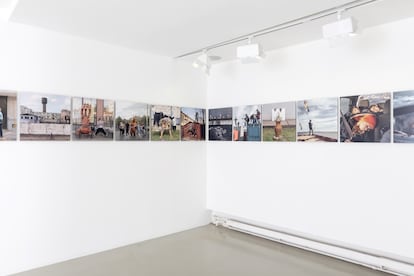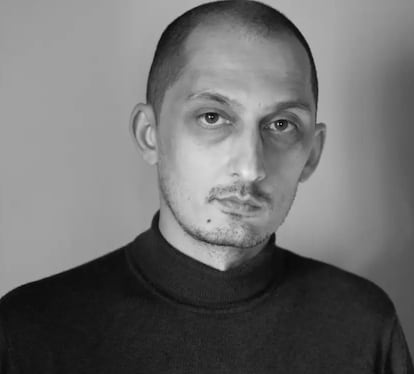The day the Russian dissident Alexei Navalny died in prison, the country was also hit by another terrible news: the loss a day earlier of the man who captured life in its most nondescript cities. Dmitri Markov (April 23, 1982-February 15, 2024) had died of an overdose at just 41 years old. The drug finally defeated the photographer after having taken away his youth, although in his stormy existence the artist managed to find a way back to his lost childhood. Márkov achieved this with his portraits of provincial youth, the same directionless kids with whom he identified. His work, executed with a simple mobile phone, was recognized by international photography agencies. Now a central gallery of the capital cultural Russia, Saint Petersburg, exhibits one of its unfinished projects.
“Dima—hypocoristic for Dmitri in Russian—spoke openly about his drug addiction. “He started using narcotics quite early, when he was about 14 years old,” recalls the director of the Anna Nova gallery, Liliana Marre, during a tour of the exhibition. the seventh heaven. “Márkov said that the drug addict begins to count the years from the moment he began to consume and that he remains trapped in his adolescence. For that reason he established that special communication with the children,” adds Marre.
Márkov worked as an editor and photographer for the newspaper Argumenty i Fakty until 2007. Visiting an orphanage to do a report pushed him to leave everything and move from Moscow to a small town in the Pskov region to work as a volunteer. For five years he took photos with his cell phone in shelters and prisons, and in 2012 he opened his Instagram account, where he posted his work. His work caught the attention of David Alan Harvey, former heavyweight at the Magnum agency, who recruited him for his project. Burn Diary —only images taken with the phone—in 2013. From then on his career as a social photographer took off, including a grant from the Getty agency and exhibitions in New York and Paris Photo.
The exhibition shows 60 images taken by the artist between 2014 and 2023 with his mobile phone, to which we must add a third floor where the gallery has other separate photographs that Márkov printed directly on metal sheets in France, without paper, and from the that the original file is not preserved. “Behind his exterior sadness and melancholy, Márkov manages to discern beauty and, most importantly, a great love, or at least hope,” the gallery emphasizes in its description of the author.
The gallery had wanted to work with Márkov since 2018, but was unable to return to this idea until the photographer broke up with his French agent in 2021. “For Dima it was a priority that this exhibition be shown in the regions,” Marre notes before adding sadly : “He wrote me a message saying that he had his concept of the project ready and that we would see it on Monday, but he didn’t have time to tell it, he died the week before.”
The composition of the exhibition has been devised by the Russian photographer Vladislav Efímov. “At the time we discarded some ideas, but Dima agreed that it would be interesting to build a part like a feed of Instagram, a metaphor for some kind of path,” says Marre. On the first floor, the photos lack indications about the story behind them and prioritize the composition.
“Despite having some characteristic feature, all Russian cities were the same for Dima, a single entity of Russia,” says the gallery director. Furthermore, what is important in the images is their shape, the plasticity of the children when they play and the faces of their protagonists: “He had a difficult childhood, but he still perceived it as something fabulous, like a fairy tale. The life of a child from a small provincial town is usually quite difficult, but when you see a dirty mattress and children jumping on it, you see the adventure they are having at that moment.”
In the opinion of Commissioner Efimov, “Markov undertook a journey whose main objective was a search for faith.” “This contradicts any scientific method and its importance often goes unnoticed by cold formalists. “It is the faith in a person in the possibility of their inner development despite the circumstances that reality imposes,” he points out.
Márkov was a professional photographer, but he composed his work with his iPhones. “He said that if he suddenly saw an image and ran for the camera, when he returned it would have disappeared,” explains Marre. That’s why I believed that the telephone was the ideal device.” “He also didn’t use any filter. I did some light correction with Lightroom, but it was minimal,” adds the director of Anna Nova.

An image of a child from a correctional facility whose face is covered by metal bars opens the second part of the exhibition. “This is a famous photograph, it is pure field work. Dima was commissioned to photograph teenagers from a juvenile center and tried for two months, but to no avail, he wanted to show a striking portrait. But one day he crossed paths with this handsome prisoner on the bank of the river and asked him to take a photograph. After several takes, he got the perfect photo,” says Marre. “His face is covered and it could be any of them.”
The artist opted for a square format for his photographs, a peculiarity that the head of the gallery highlights: “Some photographers from Soviet times used this format because there were cameras that shot exactly in a square, but most prefer another type of image because framing is actually very difficult. Dima, however, used it brilliantly.”
Dmitri Markov denounced Russian injustice even though his work focused on the positive side of the marginalized. One of his most viral photographs was taken during his own arrest for participating in the protests over Navalny’s arrest in February 2021. While sitting in the police station, he took the snapshot: a riot police officer hidden behind a balaclava remains with an absent look and hands crossed in front of the scrutinizing eyes of a portrait of Putin. Márkov donated the image to the human rights organization OVD-Info, which auctioned it for two million rubles (almost 30,000 euros at the then exchange rate).

The photographer left Moscow and returned to Pskov in his final years, but could not leave drug addiction behind. “It is such a serious illness that it is a myth to say that only with willpower can you get out of it,” laments Marre. “It was a shock for us. “We knew he was in a rehabilitation center, but we talked every two months, we didn’t expect it.”
Márkov died on February 15, one day before Navalny in a distant Arctic prison in circumstances whose official version does not agree with the leaks from the Investigative Committee. Instagram, the social network with which the artist showed the vitality of the Russian provinces, was banned by the Kremlin at the beginning of the war. The Russian government included the platform with which Markov portrayed the beauty of Russia—and where its citizens expressed themselves freely—on its list of extremist and terrorist organizations.

